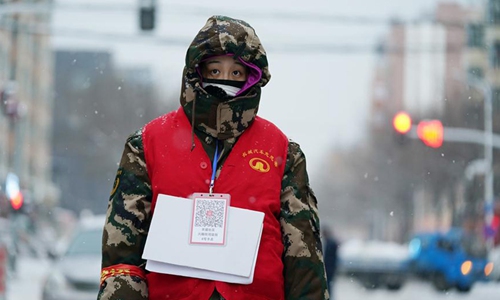Imported infection in Harbin spreads across province
By Liu Caiyu Source:Global Times Published: 2020/4/20 20:57:25
Chinese virologists fear new virus variety more infectious, harder to detect

Volunteer Li Wenqi stands in the snow at a checking point for epidemic prevention in Harbin, northeast China's Heilongjiang Province, Feb 29, 2020. Photo: Xinhua
An extra-long infection chain in Harbin, Northeast China's Heilongjiang Province, has extended to more neighboring regions, sounding the alarm over the infectivity of the imported case.
North China's Inner Mongolia Autonomous Region became the second provincial region to be affected by patients in Heilongjiang, following Liaoning Province.
Hulun Buir government said the confirmed patient in the Inner Mongolia city is related to Harbin, a city where an imported case from the US has caused infections of at least 50 people.
Epidemiologists and virologists reached by the Global Times on Monday said the long infection chain from Harbin has transformed their knowledge of the coronavirus, which may be a different genotype from the one that spread in China earlier, and they stressed the acute importance to contain the virus soon.
Zeng Guang, chief epidemiologist of the Chinese Center for Disease Control and Prevention, said "We shall pay great attention to the small-scale outbreak in Harbin, which has a clear and long infection chain, and they have exposed some new characteristics of the coronavirus," indicating the unsuspected infectivity of the disease.
Yang Zhanqiu, deputy director of the pathogen biology department at Wuhan University, told the Global Times on Monday that the genotype of the coronavirus that spread through the Harbin chain might have come from overseas and Chinese people might be more susceptible to this new coronavirus genotype.
Yang warned the outbreak in Harbin must be given full attention. If it is not fully controlled, the regional outbreak would spread widely because it comes as China is resuming work and production and population flows are recovering.
The case also underlined the importance of preventing imported cases from spreading, Yang said, noting that closed-loop management and prevention of community spread are critical.
The original imported case in Harbin was a Chinese passenger surnamed Han who flew from the US on March 19. Contact tracing revealed that more than 50 cases of COVID-19 were related to her, either directly or indirectly, including secondary clustered infections at two hospitals. Some 4,000 people are under screening to check for close contacts due to the hospital outbreak.
Han took four nucleic acid tests and antibody tests, all negative, but passed the virus to her neighbor. Local health authorities later confirmed Han had been infected with the COVID-19. Beijing on April 14 also reported an imported case from the US who was confirmed to be infected after negative test results at a hospital and the quarantine center.
"Han's case has warned us that there may be inadequacy in our detection methods. Is our test sensitive enough? Why does the coronavirus have such strong infectivity while frequent tests are negative?" Zeng asked.
An epidemiological investigation is still ongoing in the city.
Yang, as a virologist, noted that a new genotype of the virus could affect the effectiveness of China's test kits, which are developed based on virus types previously discovered in China.
Experts warned the public not to ease vigilance against the coronavirus and urged the closing of loopholes in hospital management, home quarantine, and cross-region population flow.
The Hulun Buir government reported two suspected COVID-19 cases on April 17, both with a travel history to Harbin. One of the suspected cases surnamed Liu was confirmed infected on Monday, who had been to one of the two hospitals in Harbin where clustered infections occurred, media reported.
Fushun, a city in Liaoning, had reported a confirmed patient who was related to one of the two Harbin hospitals where clustered infections occurred.
Various localities have upgraded their measures again after the Harbin outbreak, with neighboring Changchun in Jilin Province requiring those from Harbin to undergo home quarantine and take three nucleic acid tests.
Hulun Buir government told those who had been to Heilongjiang to undergo a 14-day central quarantine and another seven-day home quarantine. Hulun Buir is also doing retrospective screening and contact tracing in local communities.
Posted in: SOCIETY,CHINA FOCUS